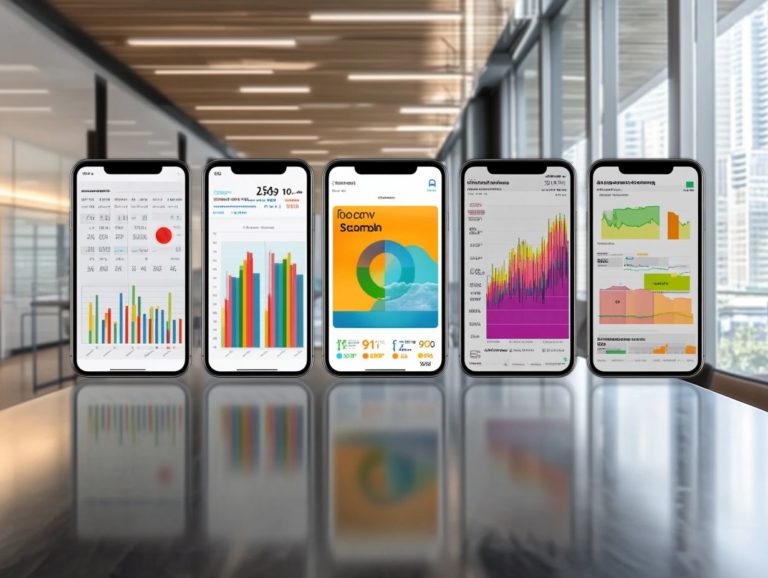How to Ensure Fairness in Performance Evaluations
Performance evaluations are essential in shaping your development and the overall success of the organization. However, fairness in these assessments is often overlooked. This oversight results in biases that can undermine morale and productivity.
This article explores the importance of fair evaluations, identifies prevalent biases, and offers best practices for creating a more equitable assessment process. It also examines strategies for addressing poor performance while emphasizing the importance of diversity and inclusion.
Join us on the journey to achieve fair and effective evaluations now!
Contents
- Key Takeaways:
- The Importance of Fairness in Performance Evaluations
- Common Biases in Performance Evaluations
- Best Practices for Fair Performance Evaluations
- Proven Strategies to Tackle Poor Performance Effectively!
- Incorporating Diversity and Inclusion in Evaluations
- Frequently Asked Questions
- How can I ensure fairness in performance evaluations?
- Why is it important to ensure fairness in performance evaluations?
- What are some common biases that can affect performance evaluations?
- How can I address biases in performance evaluations?
- What can I do if I feel my performance evaluation was unfair?
- How can I ensure consistency in performance evaluations?
Key Takeaways:

Fairness in performance evaluations is vital for both employees and organizations alike. Identifying and addressing biases is essential to ensure fair and accurate assessments. Establishing clear criteria, promoting consistency, and incorporating diversity and inclusion are key to conducting fair evaluations.
The Importance of Fairness in Performance Evaluations
Fairness in performance evaluations significantly influences not just employee performance, but also the organizational culture and the sense of workplace equity that HR leaders aspire to cultivate.
When the review process is transparent, employees feel valued. This feeling fosters greater engagement and satisfaction among the workforce. Embracing equitable performance management practices enhances performance metrics and amplifies overall contributions toward organizational success.
Why Fairness Matters for Employees and the Organization
Fairness in evaluations is crucial not just for your individual growth, but also for aligning with the broader goals of your organization and nurturing a positive workplace culture.
When you see evaluations as just and unbiased, it cultivates trust and inspires you to excel in your role. This sense of equity directly affects compensation changes. You are far more likely to accept and feel satisfied with pay adjustments when the evaluation process accurately reflects your contributions.
Organizations thrive on a cohesive team dynamic, where employees feel engaged and valued rather than disillusioned. This engagement propels collective efforts toward achieving strategic objectives. Therefore, a commitment to fairness boosts your morale and fortifies the organization as a whole.
Common Biases in Performance Evaluations
Common biases can greatly skew review ratings and diminish the effectiveness of feedback mechanisms. This presents challenges for HR leaders striving for accurate and fair assessments.
Identifying and Addressing Bias in Evaluations
Identifying and addressing bias in evaluations is crucial for ensuring that performance management systems reflect employee capabilities rather than being clouded by previous beliefs.
Utilizing structured evaluation frameworks clear guidelines for reviews and relying on data-driven metrics help recognize patterns that may reveal potential biases. It s vital for you as a manager to undergo training that fosters self-awareness and encourages you to challenge your own assumptions.
Practical steps you can take include:
- Implementing blind recruitment techniques
- Ensuring that diverse panels are present during evaluations
These actions can significantly mitigate individual biases. By fostering an open dialogue about cultural competence and establishing accountability measures, you enable yourself and your colleagues to adopt more equitable assessment practices. This commitment ultimately cultivates a fairer and more productive workplace.
Best Practices for Fair Performance Evaluations

To achieve optimal performance evaluations, it s essential to implement best practices that prioritize fairness.
Begin by establishing clear criteria that serve as the foundation for assessments. Effective communication throughout the process ensures consistency and objectivity, allowing for a more transparent appraisal experience.
Establishing Clear Criteria and Communication
Establishing clear criteria and communication channels is crucial for performance evaluations. This foundation shapes effective HR practices and aligns your goals with the organization’s expectations.
Implementing well-defined metrics ensures employees understand what is required for success. This cultivates a culture of transparency and accountability. Effective communication strategies, such as regular check-ins and constructive feedback sessions, significantly elevate this process.
These strategies assist in pinpointing areas for improvement while celebrating achievements, making employees feel valued and engaged.
By integrating these approaches, you foster an environment where performance reviews transform from mere formalities into genuine opportunities for growth and development, ultimately benefiting both individuals and the organization.
Ensuring Consistency and Objectivity
Ensuring consistency and objectivity in performance evaluations is vital for maintaining the integrity of review ratings and fostering trust between you and your employees, as well as among HR leaders.
Achieve this by implementing standardized processes that promote uniformity across evaluations. Utilizing objective metrics and clearly defined criteria effectively mitigates biases that skew perceptions of employee performance.
Offering training sessions for evaluators enhances their understanding of the evaluation criteria.
Adopting tools that provide both quantitative data and qualitative feedback delivers a more rounded perspective, making it easier for HR leaders to uphold fair assessments while recognizing individual contributions.
Proven Strategies to Tackle Poor Performance Effectively!
Addressing poor performance involves employing strategic coaching techniques and adopting a structured approach to performance enhancement.
This ensures employees receive constructive feedback along with actionable development plans tailored to their growth.
Effective Coaching and Feedback Techniques
Effective coaching and feedback techniques are crucial for enhancing employee performance and nurturing a culture of continuous improvement within your organization.
Adopting targeted coaching methods, such as situational leadership which involves adapting your leadership style to meet the needs of employees and developmental feedback, cultivates an atmosphere that promotes open communication and trust.
Employing techniques like the GROW model goal setting, reality checking, options exploration, and way forward guides employees on their professional journeys.
Regular performance reviews, paired with constructive feedback, help identify areas needing improvement while also recognizing achievements to elevate morale.
Utilizing tools like 360-degree feedback provides a comprehensive perspective on performance, giving employees the insights required to thrive and contribute meaningfully to your organization s goals.
Creating Development Plans for Improvement

Creating development plans for improvement is an essential step in your performance management process. It allows you to understand your targets clearly and the resources available to achieve them.
These plans should align with your personal aspirations while connecting to broader organizational goals, ensuring a cohesive approach to growth.
By honing in on specific skills and competencies, you can tailor strategies that address unique performance gaps, fostering a culture of continuous learning.
Engaging in the development process cultivates a sense of ownership and motivation, leading to more meaningful progress.
Incorporating regular feedback sessions enables necessary adjustments and recalibrations, emphasizing the importance of adaptability in achieving lasting performance enhancements.
Incorporating Diversity and Inclusion in Evaluations
Incorporating diversity and inclusion into your performance evaluations is crucial for fostering workplace fairness. By recognizing the unique challenges faced by different employee groups, you can significantly enhance your organization s overall success.
This approach promotes equity and cultivates a more dynamic and innovative work environment.
Considering Unique Challenges and Perspectives
Considering the unique challenges and perspectives during evaluations enriches your assessment process. This enables human resources staff to gain a deeper understanding of and support for your diverse workforce.
By acknowledging the individual experiences and obstacles faced by employees, your organization can cultivate an inclusive environment that values every contribution.
This thoughtful approach enhances the accuracy of evaluations and fosters a stronger connection between managers and team members.
When you employ tailored evaluation methods, you equip human resources staff to better identify areas for development and facilitate growth.
Recognizing diverse perspectives sparks innovative solutions that align with your organization s broader goals. This underscores the necessity for compassionate leadership that truly appreciates varied viewpoints.
Promoting Equal Opportunities for Growth and Recognition
Promoting equal opportunities for growth and recognition during evaluations creates a culture of inclusivity that motivates you to put forth your best efforts.
This approach improves both your performance and team dynamics, as you and your colleagues feel valued and enabled in your roles.
When everyone has equal access to feedback and development resources, it fosters a sense of belonging and loyalty to the organization.
A workplace that prioritizes equitable evaluations cultivates trust and transparency, allowing diverse perspectives to thrive.
Your organization reaps the rewards of improved collaboration and innovation, ultimately driving success. A fair evaluation process empowers you to excel and drives our organization forward!
Frequently Asked Questions
How can I ensure fairness in performance evaluations?

There are several steps you can take to ensure fairness in performance evaluations. These include clearly defining performance criteria, using objective measures, providing training to evaluators, and maintaining objectivity in performance reviews, as well as conducting regular evaluations.
Why is it important to ensure fairness in performance evaluations?
Fairness in performance evaluations promotes employee satisfaction and engagement. It reduces the risk of discrimination and bias and helps to identify areas for improvement and growth.
What are some common biases that can affect performance evaluations?
Common biases that can affect performance evaluations include the halo effect, where an evaluator’s overall impression of an employee influences their ratings, and the recency effect, where an employee’s most recent performance is given more weight than their overall performance.
How can I address biases in performance evaluations?
To address biases, provide training to evaluators on recognizing and avoiding biases, use objective measures and data, and conduct regular evaluations to ensure consistency.
What can I do if I feel my performance evaluation was unfair?
If you feel your evaluation was unfair, request a meeting with your supervisor to discuss your concerns and provide evidence to support your case. Seek guidance from HR or file a formal complaint if necessary.
How can I ensure consistency in performance evaluations?
To ensure consistency, clearly define performance criteria and use objective measures. Provide training to evaluators and conduct evaluations at regular intervals. Having multiple evaluators also offers different perspectives on an employee’s performance.






